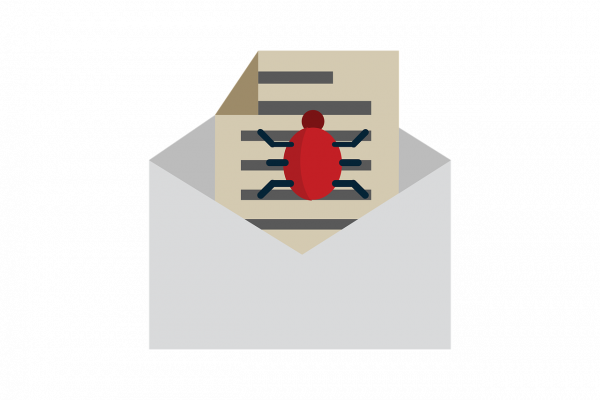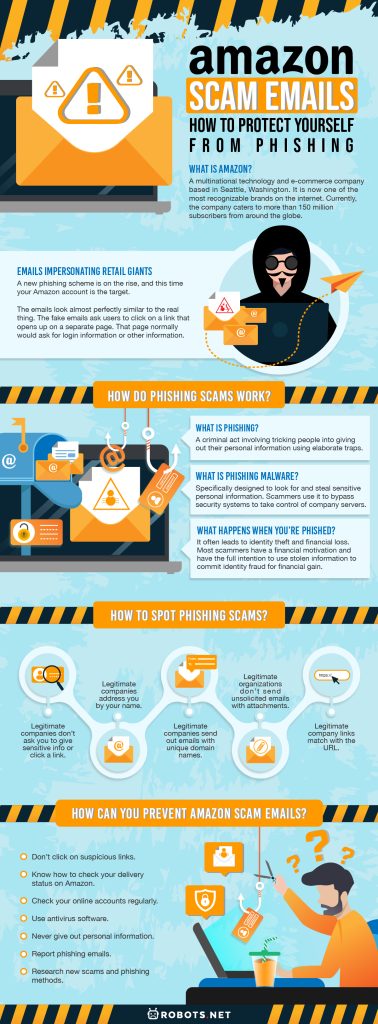Emails Impersonating Retail Giants
The emails look almost perfectly similar to the real thing. They use the exact same logos, colors, and fonts, to make the recipients trust the website or email right off the bat. Fake emails are hard to distinguish from legitimate emails since they look almost exactly the same. But the most frequent distinguishing factor is related to the presence of links. The fake emails ask users to click on a link that opens up on a separate page. That page normally would ask for login information or other information. The typical email may start off with a fake backstory. That may go along the lines of a security issue or a statement explaining why your account has been locked. In other cases, it’s about a delivery issue regarding items you didn’t buy. The backstories make people panic to get them to act without confirming the truth of the issue.
How Do Phishing Scams Work?
What Is Phishing?
Phishing is a criminal act involving tricking people into giving out their personal information using elaborate traps. As with real fishing, a malicious actor will use virtual bait in email or personal messages on social media programs. Phishing has been the bane of antivirus companies and businesses for a long time now. There are a wide variety of phishing tactics available to get victims to fall for the bait. But the most common delivery method for a phishing attempt, as we’ve mentioned, is email. When the victims open the fake email, they are faced with a false scenario requesting them to click on a link to fill in some personal information. Most links contain phishing malware that is set to download when you click on the link automatically.
What Is Phishing Malware?
Phishing malware is specifically designed to look for and steal sensitive personal information. That includes everything from login credentials, passwords, credit card numbers, and more. Phishing schemes use social engineering elements to lure their victims in. This makes it one of the most dangerous malware out there. Phishing malware also features big data theft heavily. Scammers use it to bypass security systems to take control of company servers.
What Happens When You’re Phished?
The after-effects of an attack against individuals and companies are potentially ruinous. It often leads to identity theft and financial loss. Most scammers have a financial motivation and have the full intention to use stolen information to commit identity fraud for financial gain. Alternatively, they can introduce multiple forms of malware to take over your files or your computer. A new trend is also emerging regarding the anonymous sale of stolen data on the dark web.
How to Spot Phishing Scams?
Falling prey to phishing scams is a terrible experience, but you don’t have to experience it to learn from it. The hard fact with these scams is that they will probably continue for as long as people out there fall for their schemes. But then again, nobody can really afford to get off emails completely. So the next best thing would be to learn how to distinguish phishing emails from legitimate emails. Here are a few things to help you make the distinction:
Legitimate companies don’t ask you to give sensitive info or click a link
Chances are if you receive an email from an institution asking you to provide sensitive personal information, it’s a scam. If you’re not sure about the nature of an email, just don’t click on any links or web page addresses.
Legitimate companies address you by your name.
Scammers often target their victims at random, so most fake emails feature generic salutations along the lines of “Dear Account Holder.” If an organization needed information from you, they would call you by name and ask you to call them back.
Legitimate companies send out emails with unique domain names.
Domain emails are unique email addresses legitimate companies use to communicate with their clients. You’ll notice that emails from legitimate sources indicate the company (i.e., [email protected]), which scammers cannot duplicate in full. Domain names are copyrighted and difficult to copy, which is why the best most scammers can do is to come up with a generic domain name that doesn’t match with the company’s original domain name (e.g., [email protected]; [email protected]).
Legitimate organizations don’t send unsolicited emails with attachments
Unsolicited emails that contain attachments, especially those attachments that end with .zip or .exe, are most definitely dangerous. Most legitimate companies would rather direct you to a download link that leads to a legitimate file source from their own website. Nevertheless, this method isn’t foolproof. Some companies that already have your information can and sometimes do send emails with real documents attached. In that case, be on the lookout for high-risk attachments in .exe, .scr, and .zip format.
Legitimate company links match with the URL.
Just because a link tells you that it will send you to a place doesn’t mean it will really lead you there. Hackers often create fake web pages that download malware the moment you enter them. In that case, cross-check the link in the text of the email and the actual URL. If the two don’t match or a hyperlink’s URL seems completely unrelated to the email topic, don’t trust the email.
Don’t click on suspicious links.
You should see the delivery status of your package on the same page. Note that international shipments that are handled by third-party delivery services cannot be tracked on the website. Meanwhile, customers who experience problems with deliveries, or find erroneous delivery status on their pages should visit: About Missing Packages That Show as Delivered or About Missing Tracking Information.
Check your online accounts regularly.
Most cybercriminals are fueled by financial gain and would get into your bank account the first chance they get. Checking your accounts on a regular basis is a good habit to have, as this will allow you to catch potential discrepancies in your funds. It’s also a good idea to change your passwords regularly. This is just in case an outsider gets hold of your password. Also, remember to use unique passwords for each of your accounts. Never reuse passwords, especially those that you use for your financial accounts.
Use antivirus software.
One cannot overemphasize the importance of reliable antivirus software. Antivirus software scans every file that comes through over the internet, and that includes your emails. Suppose you ever click on a malicious link by accident. In that case, the software can detect the malware and stop the download from completing. Antivirus software equipped with anti-spyware and firewall is also crucial for preventing phishing attacks. To find the best antivirus for your security needs and budget, check out this list of the best antivirus software.
Never give out personal information.
The internet may be a fun place to be, but it’s not the safest place to share personal information. Some people will dismiss this as a common-sense thing, but you’d be surprised at the numbers of people who have become victims of identity theft. Most of these attacks probably stemmed from oversharing on social media and other platforms. Remember that your personal information, much less your financial information, has no business on Facebook, Twitter, or any other social media website.
Report phishing emails.
Research new scams and phishing methods.
Cybercriminals are highly creative in designing phishing attacks. The methods they use always change depending on their objectives. Keep yourself abreast with the latest trends in cyber-crime so you’ll know how to spot it when you see it. Also, check out this list of helpful tips to prevent identity theft online. Cybercriminals will never stop coming up with new malware and phishing traps. It’s a good thing then that cybersecurity companies keep pace by advancing new methods to track malware. An example would be the STAMINA method using deep learning to track malware. We might not be able to fight fire with fire, but we can extinguish it with knowledge and vigilance.






